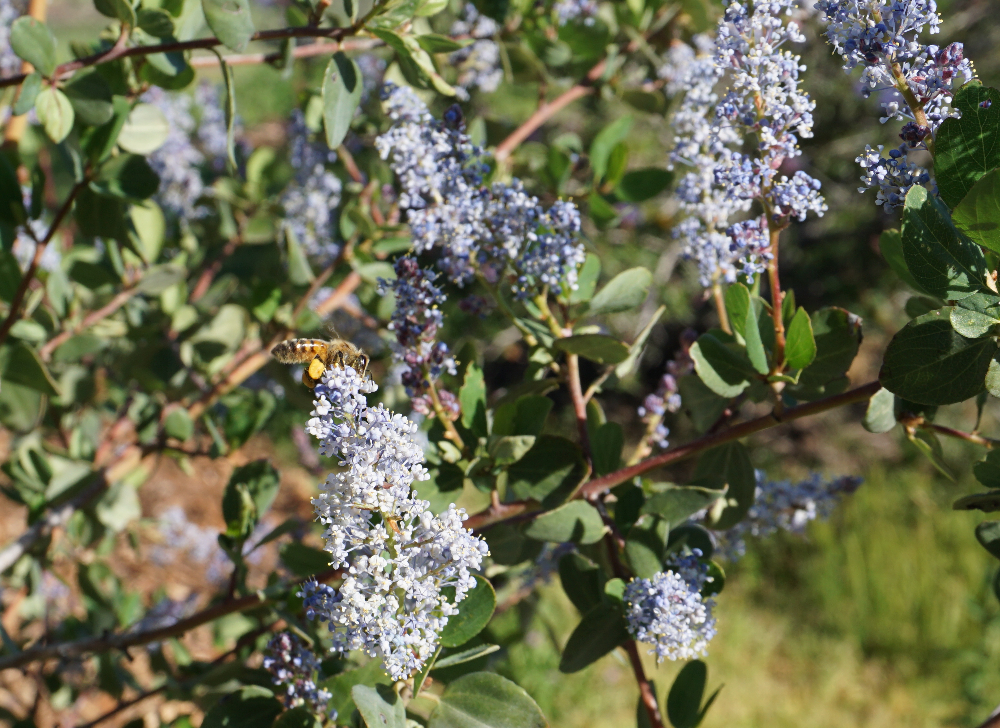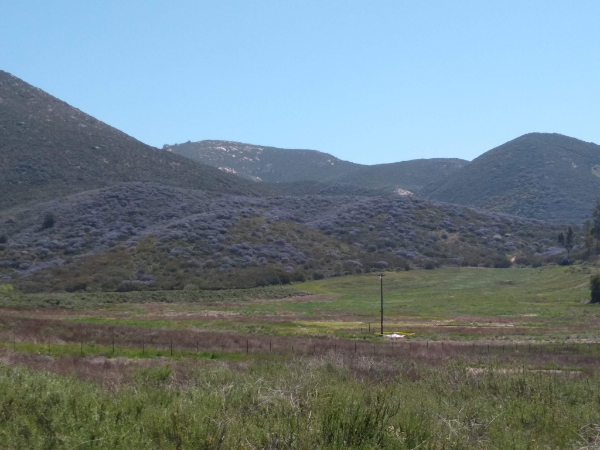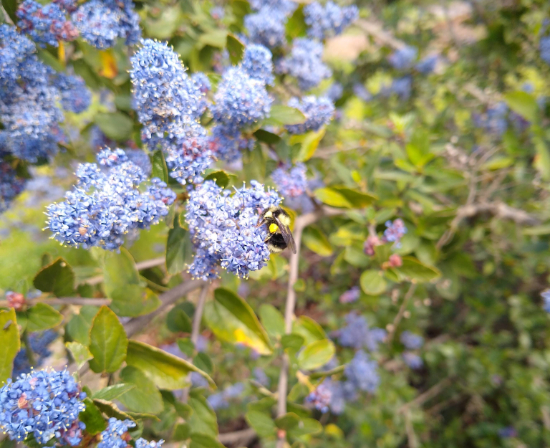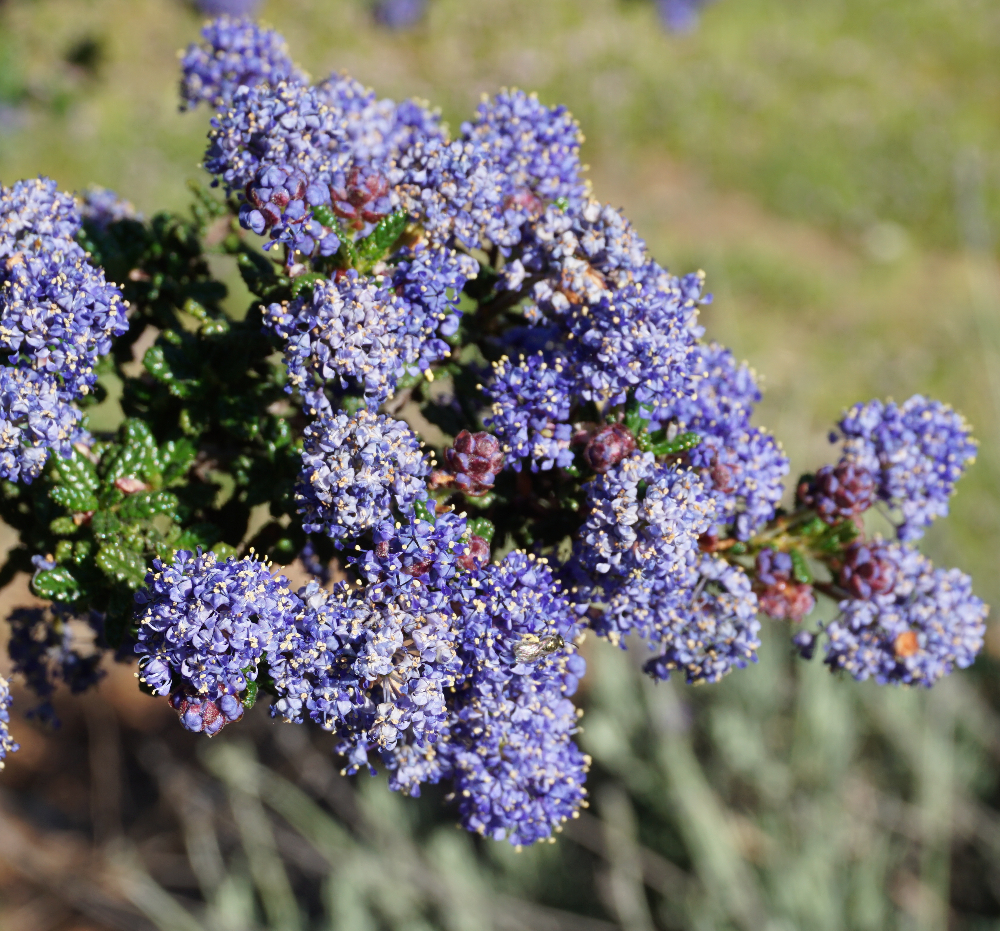Take a drive out of town here in early spring and you can’t miss the blue bushes glowing on the California hillsides. There’s nothing else like them. What are they? Ceanothus some people call them, or wild lilac they’re called by others, and some refer to them as California lilacs.
If you drive around enough, or hike around to get a closer look, you’ll notice that the ceanothus bushes vary. Some are very thorny while others are less so. Some have flowers that are a rich blue, like this ceanothus ‘South Coast Blue’ in my yard.
Others have flowers that are only tinged blue.
In fact, there are types whose flowers have no blue — they’re totally white — such as Ceanothus crassifolius, which start blooming in the winter long before the blue types in my part of San Diego County open up. But it’s the blue blooms of ceanothus which catch our eyes because of their uniqueness.
Where do they grow?
Ceanothus bushes grow wild throughout much of California, especially on the hillsides in the southern half of the state.
Do ceanothus grow in your neighborhood? Look it up on Calscape or Calflora.
Wild and cultivated
But since they are so beautiful, people have been growing them deliberately in their gardens for a long time too.
You can grow the wild types in your yard. A few years back I transplanted into my yard a sapling of Ceanothus leucodermis that was growing wild in a neighbor’s yard.
You can also grow types of ceanothus that have been found in gardens or nurseries or elsewhere and have been propagated by professionals specifically to sell to gardeners. Ceanothus ‘Joyce Coulter’ is one such variety that I have in my yard, seen in this video.
Some of our native bees in California are attracted to ceanothus flowers, which is one of the main reasons I grow them. (I included ceanothus in my “Bee Garden.”)
How to grow ceanothus in your yard
Most of my ceanothus bushes were grown by a nursery in Valley Center in San Diego County called Moosa Creek. You can buy many kinds of ceanothus bushes from nurseries like Moosa Creek. Other nurseries that sell ceanothus include Las Pilitas in Santa Margarita near San Luis Obispo, Tree of Life in San Juan Capistrano, and Theodore Payne in Sun Valley near Los Angeles.
Winter is my favorite time to plant a ceanothus, but I’ve also had good results planting in late fall and early spring.
My yard’s soil drains fast, and it seems that ceanothus bushes like that. All of the wild ceanothus bushes I know are growing on hillsides with light soils.
I don’t irrigate my ceanothus bushes although I do sometimes add extra rainwater around them in the winter, and during their first summer I usually give them water about once each month.
I add a mulch of wood chips around my ceanothus bushes, which conserves some of the winter rainfall and suppresses some weed growth.
They’re native plants though. We have to remember that. So once they’ve been watered in at planting, maybe had some mulch applied, and maybe had occasional water during their first summer, they don’t need our help. Let them enjoy this California climate that they’re suited for.
And let various bees enjoy the ceanothus flowers, for which they’re suited.

All of my Yard Posts are listed HERE









Beautiful blue! Would this be able to be kept trimmed as a foundation plant in a 3×3
area surrounding hardscape?
Possibly. I have one that only gets a foot or two tall and spreads like a ground cover. I’ve never pruned it but it could probably be pruned to keep it in bounds. It’s ceanothus griseus: https://www.monrovia.com/yankee-point-california-lilac.html
I’m surprised that you didn’t mention the characteristic of Ceanothus that made them a big draw for my kids and earned the plant the affectionate nickname “soap flower.” When we were out camping and the kids wanted to wash their hands, they’d pick of few sprigs of ceanothus flowers, and a bit of water and then rub their hands together as if they had some soap in there too. It was surprising how much lather resulted and how much cleaner their hands were afterwards. I think we experimented with a shampoo version, but ended up with too much detritus stuck in the hair!
That’s awesome! I had no idea. I will be trying it with my kids. Thanks, Ellen.
Grow Native Nursery in Claremont sells ceanothus too!
Thank you, Holly. Even though I grew up near Claremont, I’ve never been to the botanic garden or nursery there. I need to make that trip!
Have you made it to the botanic garden yet? Spectacular place! A must visit for So Cal gardeners!!! UC Riverside has one too!
Does this bush grow in the Redlands, CA area (near San Bernardino). Do any nurseries in that area carry it?
Hi Elizabeth,
It looks like ceanothus grows fine in Redlands. Here’s a search you can look at: https://www.calflora.org/entry/wgh.html#srch=t&taxon=Ceanothus&nplace=Redlands&fmt=photo&inma=t&y=34.0555&x=-117.1825&z=12
And here’s another one: https://www.calscape.org/loc-34.0564,-117.2059(Redlands)/Ceanothus%20(all)?&poploc=1&srchcr=sc62339bca815e6
You can some in Caroline Park.
How large has your ‘south cost blue’ grown? I’m wondering if it would be compact enough for a particular spot in my yard.
Hi Chris,
Here in March 2022, my South Coast Blue is 10 feet tall and 16 feet wide. It hasn’t been pruned overall, but I do prune it on one side so I can drive next to it and it takes well to the pruning.
Thank you for this post. By planting a few different Ceanothus, I recently observed that the staggered bloom is a real draw for pollinators, bringing them in during winter and keeping them here through the spring. Love these plants!
I just finished reading Gaia’s Garden and the author mentioned that Ceanothus is a nitrogen fixer (when planted near a tree it fixes nitrogen in the soil). I’m new to the guild concept but it’s worth a try.
That book was so interesting!! The description of how refined nitrogen cuts the soil bacteria out of the loop was a lightbulb moment, and I was so interested to learn that nitrogen fixers actually do feed their neighbors as they grow. I’ve been planting some clover near my food plants to see if it helps.
I love Ceanothus Joyce Coulter but am having a difficult time finding a retailer that will ship to me in Georgia. If anyone knows of such a nursery I would greatly appreciate any info you could offer.
Have you seen any lilac cultivars thrive in 2 hours/day direct sun?
Hi Sally,
I can’t think of any I’ve seen in that much shade. In the wild, I always see them in sunnier locations and not, for example, in the shade of a big oak. I would guess that a ceanothus growing in more shade would be healthy but flower less.